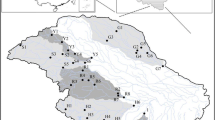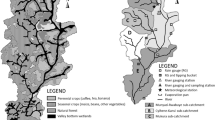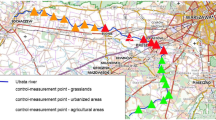Abstract
Globally, rivers and streams are experiencing declining water quality. Anthropogenic activities largely contribute to surface water pollution. Understanding human-induced influence on river water quality remains a challenge owing to spatiotemporal variations. In this study, we assessed the influence of various land uses (LU) on 16 water quality parameters of the Mun River, a tributary of the Mekong River, at different scales. Water quality was statistically analyzed both spatially and temporally (1995–2010). Seasonal and annual effect of LU on water quality was evaluated at buffer zone scale and sub-basin scale (i.e., catchment scale) using multiple regression analysis. The result showed that urban LU extensively adds to the nutrient concentration [i.e., total phosphorus (TP), ammonia nitrogen (NH3-N)] followed by agriculture LU at the sub-basin scale. Site-specific variability of TP is explained by urban LU and biological oxygen demand (BOD) by agriculture LU at the 5-km buffer in Upper and Middle Mun whereas at Lower Mun, the 20-km buffer explains the variability of suspended solids (SS) and total suspended solids (TSS), suggesting a more localized effect on the parameters upstream. The high concentration of parameters was noted in the dry season whereas the opposite was true for fecal coliform bacteria (FCB), SS, and TP. The maximum parameter concentration of NH3-N, FCB, and total coliform bacteria exceeds the permissible surface water quality standards of the Pollution Control Department (PCD) of Thailand in all three sub-basins. The study suggests the need for multi-scale interventions and effective pollution control measures focusing on nutrient, pathogenic bacteria, and solids pollution to improve the river water quality of large river basin.





Similar content being viewed by others
References
Akter, A., & Babel, M. S. (2012). Hydrological modeling of the Mun River Basin in Thailand. Journal of Hydrology, 452-453, 232–246. https://doi.org/10.1016/j.jhydrol.2012.05.059.
Bian, B., Zhou, Y., & Fang, B. B. (2016). Distribution of heavy metals and benthic macroinvertebrates: impacts from typical inflow river sediments in the Taihu Basin, China. Ecological Indicators, 69, 348–359. https://doi.org/10.1016/j.ecolind.2016.04.048.
Bilotta, G. S., & Brazier, R. E. (2008). Understanding the influence of suspended solids on water quality and aquatic biota. Water Research, 42(12), 2849–2861. https://doi.org/10.1016/j.watres.2008.03.018.
Bu, H., Meng, W., Zhang, Y., & Wan, J. (2014). Relationships between land use patterns and water quality in the Taizi River basin, China. Ecological Indicators, 41, 187–197. https://doi.org/10.1016/j.ecolind.2014.02.003.
Calazans, G. M., Pinto, C. C., da Costa, E. P., Perini, A. F., & Oliveira, S. C. (2018). The use of multivariate statistical methods for optimization of the surface water quality network monitoring in the Paraopeba River basin, Brazil. Environmental Monitoring and Assessment, 190(8), 1–15. https://doi.org/10.1007/s10661-018-6873-2.
Chea, R., Grenouillet, G., & Lek, S. (2016). Evidence of water quality degradation in Lower Mekong Basin revealed by self-organizing map. PLoS One, 11(1), e0145527. https://doi.org/10.1371/journal.pone.0145527.
Deb, P., Babel, M. S., & Denis, A. F. (2018a). Multi-GCMs approach for assessing climate change impact on water resources in Thailand. Modeling Earth Systems and Environment, 4(2), 825–839. https://doi.org/10.1007/s40808-018-0428-y.
Deb, P., Debnath, P., Denis, A. F., & Lepcha, O. T. (2018b). Variability of soil physicochemical properties at different agroecological zones of Himalayan region: Sikkim, India. Environment, Development and Sustainability. https://doi.org/10.1007/s10668-018-0137-8.
Deb, P., Kiem, A. S., & Willgoose, G. (2019a). A linked surface water-groundwater modelling approach to more realistically simulate rainfall-runoff non-stationarity in semi-arid regions. Journal of Hydrology, 575, 273–291. https://doi.org/10.1016/j.jhydrol.2019.05.039.
Deb, P., Kiem, A. S., & Willgoose, G. (2019b). Mechanisms influencing non-stationarity in rainfall-runoff relationships in southeast Australia. Journal of Hydrology, 571, 749–764. https://doi.org/10.1016/j.jhydrol.2019.02.025.
Ding, J., Jiang, Y., Liu, Q., Hou, Z., Liao, J., Fu, L., & Peng, Q. (2016). Influences of the land use pattern on water quality in low-order streams of the Dongjiang River basin, China: a multi-scale analysis. Science of the Total Environment, 551–552(19), 205–216. https://doi.org/10.1016/j.scitotenv.2016.01.162.
Duncan, E., Kleinman, P. J., & Sharpley, A. N. (2012). Eutrophication of lakes and rivers. eLS, (February), 1–8. https://doi.org/10.1002/9780470015902.a0003249.pub2.
Giri, S., & Qiu, Z. (2016). Understanding the relationship of land uses and water quality in twenty first century: a review. Journal of Environmental Management, 173, 41–48. https://doi.org/10.1016/j.jenvman.2016.02.029.
Grove, M. K., Bilotta, G. S., Woockman, R. R., & Schwartz, J. S. (2015). Suspended sediment regimes in contrasting reference-condition freshwater ecosystems: implications for water quality guidelines and management. Science of the Total Environment, 502, 481–492. https://doi.org/10.1016/j.scitotenv.2014.09.054.
Güler, C., Thyne, G. D., McCray, J. E., & Turner, A. K. (2002). Evaluation of graphical and multivariate statistical methods for classification of water chemistry data. Hydrogeology Journal, 10(4), 455–474. https://doi.org/10.1007/s10040-002-0196-6.
Hashemi Monfared, S. A., Dehghani Darmian, M., Snyder, S. A., Azizyan, G., Pirzadeh, B., & Azhdary Moghaddam, M. (2017). Water quality planning in rivers: assimilative capacity and dilution flow. Bulletin of Environmental Contamination and Toxicology, 99(5), 531–541. https://doi.org/10.1007/s00128-017-2182-7.
https://earthexplorer.usgs.gov/. (n.d.). USGS. https://earthexplorer.usgs.gov/
Kalin, L., Isik, S., Schoonover, J. E., & Lockaby, B. G. (2010). Predicting water quality in unmonitored watersheds using artificial neural networks. Journal of Environmental Quality, 39(4), 1429–1440 https://www.ncbi.nlm.nih.gov/pubmed/20830930.
Kändler, M., Blechinger, K., Seidler, C., Pavlů, V., Šanda, M., Dostál, T., Krása, J., Vitvar, T., & Štich, M. (2017). Impact of land use on water quality in the upper Nisa catchment in the Czech Republic and in Germany. Science of the Total Environment, 586, 1316–1325. https://doi.org/10.1016/j.scitotenv.2016.10.221.
Kruawal, K., Sacher, F., Werner, A., Müller, J., & Knepper, T. P. (2005). Chemical water quality in Thailand and its impacts on the drinking water production in Thailand. Science of the Total Environment, 340(1–3), 57–70. https://doi.org/10.1016/j.scitotenv.2004.08.008.
Kulinkina, B. A. V., Shinee, E., Rafael, B., Herrador, G., Nygård, K., & Schmoll, O. (2016). The situation of water-related infectious diseases in the pan-European region, 42. ISBN 9 789289 052023
Kumar, P., Dasgupta, R., Johnson, B. A., Saraswat, C., Basu, M., Kefi, M., & Mishra, B. K. (2019). Effect of land use changes on water quality in an ephemeral coastal plain: Khambhat City, Gujarat, India. Water (Switzerland), 11(4). https://doi.org/10.3390/w11040724.
Lai, Y. C., Yang, C. P., Hsieh, C. Y., Wu, C. Y., & Kao, C. M. (2011). Evaluation of non-point source pollution and river water quality using a multimedia two-model system. Journal of Hydrology, 409(3–4), 583–595. https://doi.org/10.1016/j.jhydrol.2011.08.040.
Lintern, A., Webb, J. A., Ryu, D., Liu, S., Bende-Michl, U., Waters, D., Leahy, P., Wilson, P., & Western, A. W. (2017). Key factors influencing differences in stream water quality across space. Wiley Interdisciplinary Reviews: Water, 5(February), e1260. https://doi.org/10.1002/wat2.1260.
Molle, F. (2007). Scales and power in river basin management: the Chao Phraya River in Thailand. Geographical Journal., 173, 358–373. https://doi.org/10.1111/j.1475-4959.2007.00255.x.
MRC. (2007). Diagnostic study of water quality in the Lower Mekong Basin. MRC Technical Paper No. 15, (15), 57 pp.
NSO, T. (2012). National Statistical Office. Ministry of Information and Communication Technology, Thailand. http://web.nso.go.th/.
Palmer-Felgate, E. J., Mortimer, R. J. G., Krom, M. D., & Jarvie, H. P. (2010). Impact of point-source pollution on phosphorus and nitrogen cycling in stream-bed sediments. Environmental Science and Technology, 44(3), 908–914. https://doi.org/10.1021/es902706r.
PCD. (2008). Pollution Control Department, Thailand. http://www.pcd.go.th/.
PCD. (2018). Pollution Control Department [47], pp. 47–62. http://www.pcd.go.th/file/14-06-61.pdf.
Pink, R. M. (2016). Thailand: a struggle against climate-change flooding. In Water rights in Southeast Asia and India (pp. 187–206). New York: Palgrave Macmillan, Springer US. https://doi.org/10.1057/9781137504234_9.
Poole, G. C. (2002). Fluvial landscape ecology: addressing uniqueness within the river discontinuum. Freshwater Biology, 47(4), 641–660. https://doi.org/10.1046/j.1365-2427.2002.00922.x.
Prabnakorn, S., Maskey, S., Suryadi, F. X., & de Fraiture, C. (2018). Rice yield in response to climate trends and drought index in the Mun River Basin, Thailand. Science of the Total Environment, 621, 108–119. https://doi.org/10.1016/j.scitotenv.2017.11.136.
Pratt, B., & Chang, H. (2012). Effects of land cover, topography, and built structure on seasonal water quality at multiple spatial scales. Journal of Hazardous Materials, 209–210, 48–58. https://doi.org/10.1016/j.jhazmat.2011.12.068.
Ribolzi, O., Cuny, J., Sengsoulichanh, P., Mousques, C., Soulileuth, B., & Pierret, A. (2011). Land use and water quality along a Mekong tributary in Northern Lao P.D.R. Environmental Management, 47(2), 291–302. https://doi.org/10.1007/s00267-010-9593-0.
Rochelle-Newall, E. J., Ribolzi, O., Viguier, M., Thammahacksa, C., Silvera, N., Latsachack, K., Dinh, R. P., Naporn, P., Sy, H. T., Soulileuth, B., Hmaimum, N., Sisouvanh, P., Robain, H., Janeau, J. L., Valentin, C., Boithias, L., & Pierret, A. (2016). Effect of land use and hydrological processes on Escherichia coli concentrations in streams of tropical, humid headwater catchments. Scientific Reports, 6(August), 1–12. https://doi.org/10.1038/srep32974.
Schaffner, M., Bader, H. P., & Scheidegger, R. (2009). Modeling the contribution of point sources and non-point sources to Thachin River water pollution. Science of the Total Environment, 407(17), 4902–4915. https://doi.org/10.1016/j.scitotenv.2009.05.007.
Seeboonruang, U. (2012). A statistical assessment of the impact of land uses on surface water quality indexes. Journal of Environmental Management, 101, 134–142. https://doi.org/10.1016/j.jenvman.2011.10.019.
Shi, P., Zhang, Y., Li, Z., Li, P., & Xu, G. (2017). Influence of land use and land cover patterns on seasonal water quality at multi-spatial scales. Catena, 151, 182–190. https://doi.org/10.1016/j.catena.2016.12.017.
Shrestha, S., & Kazama, F. (2007). Assessment of surface water quality using multivariate statistical techniques: a case study of the Fuji River basin, Japan. Environmental Modelling and Software, 22(4), 464–475. https://doi.org/10.1016/j.envsoft.2006.02.001.
Silva, S. V. S., Dias, A. H. C., Dutra, E. S., Pavanin, A. L., Morelli, S., & Pereira, B. B. (2016). The impact of water pollution on fish species in southeast region of Goiás, Brazil. Journal of Toxicology and Environmental Health, 79(1), 8–16. https://doi.org/10.1080/15287394.2015.1099484.
Sliva, L., & Williams, D. D. (2001). Buffer zone versus whole catchment approaches to studying land use impact on river water quality. Water Research, 35(14), 3462–3472.
Sudaryanto, A., Isobe, T., Takahashi, S., & Tanabe, S. (2011). Assessment of persistent organic pollutants in sediments from Lower Mekong River Basin. Chemosphere, 82(5), 679–686. https://doi.org/10.1016/j.chemosphere.2010.11.004.
Tran, C. P., Bode, R. W., Smith, A. J., & Kleppel, G. S. (2010). Land-use proximity as a basis for assessing stream water quality in New York State (USA). Ecological Indicators, 10(3), 727–733. https://doi.org/10.1016/j.ecolind.2009.12.002.
UNEP. (2016). A snapshot of the world’s water quality: towards a global assessment. 978-92-807-3555-0
United Nations. (2018). The United Nations World Water Development Report 2018: nature-based solutions for water. http://unesdoc.unesco.org/images/0026/002614/261424e.pdf.
Vrebos, D., Beauchard, O., & Meire, P. (2017). The impact of land use and spatial mediated processes on the water quality in a river system. Science of the Total Environment, 601–602, 365–373. https://doi.org/10.1016/j.scitotenv.2017.05.217.
Walling, D. E. (2006). Human impact on land-ocean sediment transfer by the world’s rivers. Geomorphology, 79(3–4), 192–216. https://doi.org/10.1016/j.geomorph.2006.06.019.
World Bank. (2011). Thailand environment monitor: integrated water resources management—a way forward. http://documents.worldbank.org/curated/en/2011/06/14600150/thailand-environment-monitor-integrated-water-resources-management-way-forward.
Xiao, R., Wang, G., Zhang, Q., & Zhang, Z. (2016). Multi-scale analysis of relationship between landscape pattern and urban river water quality in different seasons. Scientific Reports, 6(November 2015), 1–10. https://doi.org/10.1038/srep25250.
Yadav, S., Yoneda, M., Tamura, M., Susaki, J., Ishikawa, K., & Yamashiki, Y. (2017). A satellite-based assessment of the distribution and biomass of submerged aquatic vegetation in the optically shallow basin of Lake Biwa. Remote Sensing, 9(9), 966. https://doi.org/10.3390/rs9090966.
Yongsi, H. B. N. (2010). Suffering for water, suffering from water: access to drinking-water and associated health risks in Cameroon. Journal of Health, Population and Nutrition, 28(5), 424–435. https://doi.org/10.3329/jhpn.v28i5.6150.
Yu, S., Xu, Z., Wu, W., & Zuo, D. (2016). Effect of land use types on stream water quality under seasonal variation and topographic characteristics in the Wei River basin, China. Ecological Indicators, 60, 202–212. https://doi.org/10.1016/j.ecolind.2015.06.029.
Zhang, L., Xu, E. G., Li, Y., Liu, H., Vidal-Dorsch, D. E., & Giesy, J. P. (2018). Ecological risks posed by ammonia nitrogen (AN) and un-ionized ammonia (NH3) in seven major river systems of China. Chemosphere, 202. https://doi.org/10.1016/j.chemosphere.2018.03.098.
Zhou, P., Huang, J., Pontius, R. G., & Hong, H. (2016). New insight into the correlations between land use and water quality in a coastal watershed of China: does point source pollution weaken it? Science of the Total Environment, 543, 591–600. https://doi.org/10.1016/j.scitotenv.2015.11.063.
Acknowledgments
The authors are particularly grateful to the Royal Irrigation Department (RID), Thai Meteorological Department (TMD), and Land Development Department (LDD) for providing the data needed for this study.
Funding
This research study was financially supported by the Royal Thai Government (RTG, His Majesty the King's Scholarship).
Author information
Authors and Affiliations
Corresponding author
Additional information
Publisher’s note
Springer Nature remains neutral with regard to jurisdictional claims in published maps and institutional affiliations.
Rights and permissions
About this article
Cite this article
Yadav, S., Babel, M.S., Shrestha, S. et al. Land use impact on the water quality of large tropical river: Mun River Basin, Thailand. Environ Monit Assess 191, 614 (2019). https://doi.org/10.1007/s10661-019-7779-3
Received:
Accepted:
Published:
DOI: https://doi.org/10.1007/s10661-019-7779-3




